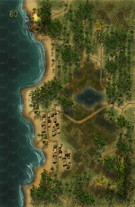|
Invalid Address Leyte '44 #40 |
||
|---|---|---|
| (Attacker) Japan | vs | United States (Defender) |
| Formations Involved |
|---|

|
| Overall Rating, 2 votes |
|---|
|
2.5
|
| Scenario Rank: --- of 957 |
| Parent Game | Leyte '44 |
|---|---|
| Historicity | Historical |
| Date | 1944-12-11 |
| Start Time | 23:30 |
| Turn Count | 15 |
| Visibility | Night |
| Counters | 63 |
| Net Morale | 0 |
| Net Initiative | 1 |
| Maps | 1: 80 |
| Layout Dimensions | 43 x 28 cm 17 x 11 in |
| Play Bounty | 153 |
| AAR Bounty | 166 |
| Total Plays | 2 |
| Total AARs | 1 |
| Battle Types |
|---|
| Delaying Action |
| Exit the Battle Area |
| Inflict Enemy Casualties |
| Conditions |
|---|
| Off-board Artillery |
| Smoke |
| Illumination |
| Scenario Requirements & Playability | |
|---|---|
| Leyte '44 | Base Game |
| Saipan 1944 | Maps + Counters |
| Introduction |
|---|
|
Among the emergency reinforcements rushed to Leyte by Gen. Tomoyuki Yamashita at 14th Area Army was a force of Special Naval Landing Force troops including tanks and mortars. It’s unclear whether the Japanese thought Ormoc was still in their hands, or if they were trying to surprise the Americans with a nighttime landing right in the port. The Americans were not fooled. |
| Conclusion |
|---|
|
The Japanese came directly for the concrete pier at Ormoc, and the Americans met them with a torrent of fire. At least one Japanese sailor yelled “Don’t Shoot!” but the Americans ignored him. Japanese landing barges continued to appear throughout the night, and at least some of them disgorged troops and vehicles that slipped away from the Americans to join the ever-weakening Thirty-Fifth Army. |
| AFV Rules Pertaining to this Scenario's Order of Battle |
|---|
|
| 1 Errata Item | |
|---|---|

|
The A4 has an inherent leader and two combat steps. Its counter should have been given an amphibious armor symbol. (Shad
on 2013 May 06)
|
| Leyte 1944, Scenario Forty: Invalid Address | ||||||||||||
|---|---|---|---|---|---|---|---|---|---|---|---|---|
Leyte 1944, Scenario Forty: Invalid Address This is kind of a novelty scenario but after reading about it, I had to get it into the scenario mix and try and make it work. The Japanese are trying to land SNLF reinforcements at Ormoc not knowing it has already fallen into American hands. It is night and the Japanese land uncoordinated troops filled barges, transports, Daihatsus and Type 2 Ka-Mi amphibious tanks into the teeth of the American units. Story has it, this is the first time in history one amphibious tank sunk another. In my game, the Americans setup first and have to spread-out across the maps, as they don’t know where the Japanese will enter and this gives the Japanese a small chance to see where to make they landings and the best American opening to push inland. The Japanese decide to hit the weaker defended north area in the American lines and all hell breaks loose soon after that. A number of strange engagements happen and the Japanese find a small hole and push some units through it and by the end of the scenario have pushed four good order units off the east edge of the maps even after the American shift their lines to engage but only achieving one out of three victory objectives, the Americans win a minor victory. This scenario clearly favors the Americans but it is pretty fun to play and see if you can get either side to do better historically. |
||||||||||||
| 0 Comments |

 Leyt039
Leyt039 

























